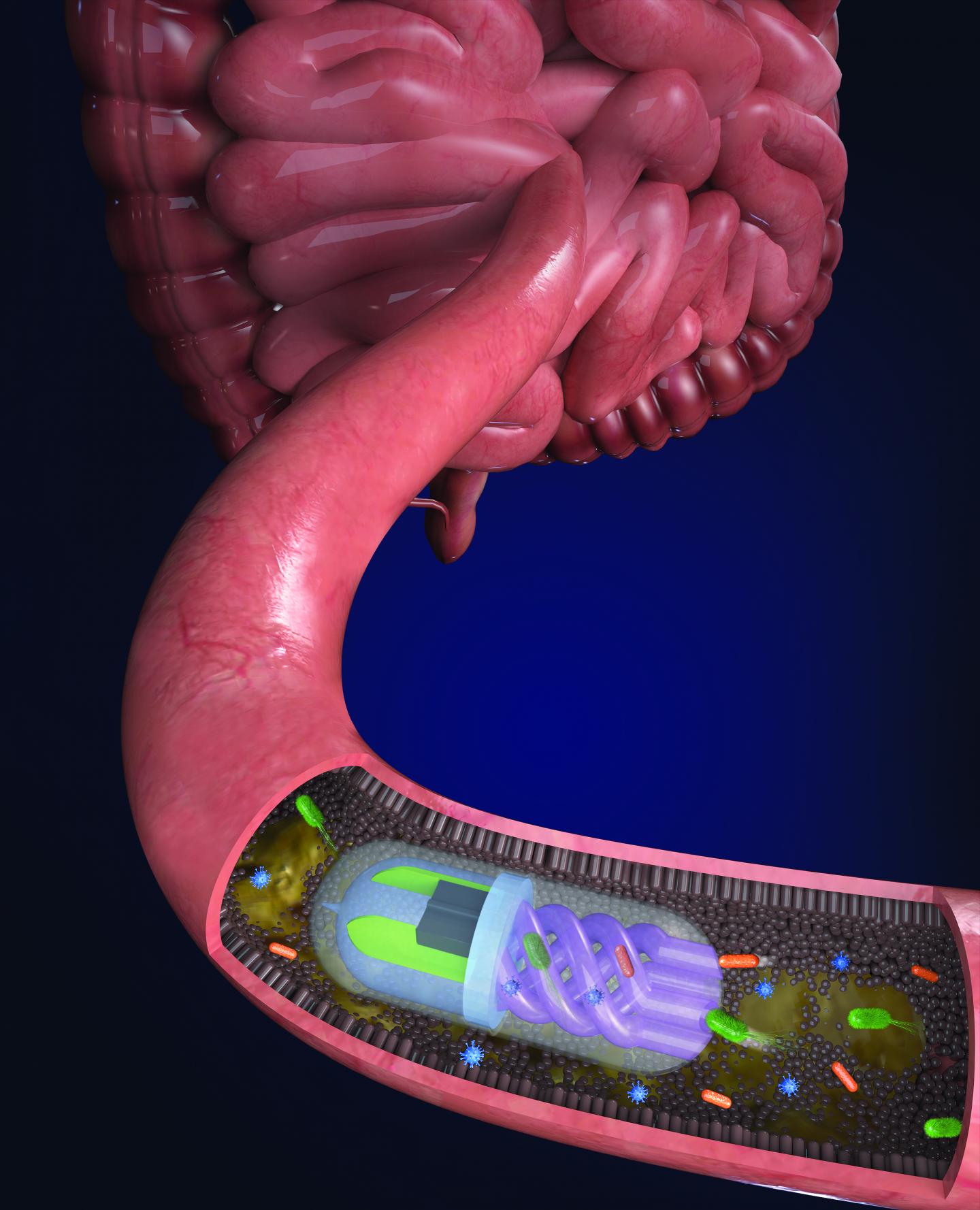The pill is the first known working device capable of non-invasively and accurately assessing the profile of bacterial species inhabiting any stage of the gastrointestinal tract

Credit: Nano Lab, Tufts University
MEDFORD/SOMERVILLE, Mass. (July 24, 2019) — A research team led by Tufts University engineers has developed a 3D printed pill that samples bacteria found in the gut — known as the microbiome — as it passes through the gastrointestinal tract (GI). The ability to profile bacterial species inhabiting the gut could have important implications for the diagnosis and treatment of conditions that are affected by the microbiome, according to the researchers.
The 3D printed pill described in the journal Advanced Intelligent Systems represents the first non-invasive diagnostic tool capable of providing a profile of microbiome populations throughout the entire GI tract, according to the researchers. Current methods of sampling the microbiome involve analysis of fecal DNA and metabolites, but that approach provides little information of the environment upstream of the distal colon, where bacterial species can vary significantly.
The pill has been studied and found to provide accurate identification of bacterial populations and their relative abundance in both in vitro and in vivo applications, the paper says. It has been tested in pigs and primates, yet clinical trials will be needed to determine if the pill can be used routinely in humans for clinical care.
More than 1,000 species of bacteria can inhabit the gut. The vast majority of these bacteria have a beneficial, supportive role in digestion and protection against disease. When the natural balance of the microbiome is skewed, a condition called “dysbiosis” occurs, which can be associated with inflammation, susceptibility to infections, and even the exacerbation of other diseases such as cancer. Research is increasingly unveiling specific microbiome metabolites that have beneficial or protective effects for the host against disease.
“We are learning quite a lot about the role of gut microbiome in health and disease. However, we know very little about its biogeography,” said Sameer Sonkusale, professor of electrical and computer engineering at Tufts University’s School of Engineering and corresponding author of the study. “The pill will improve our understanding of the role of spatial distribution in the microbiome profile to advance novel treatments and therapies for a number of diseases and conditions.”
The pill is more sophisticated than just a sponge. It is manufactured in a 3D printer with microfluidic channels that can sample different stages of the GI tract. The surface of the pill is covered with a pH sensitive coating, so that it does not absorb any samples until it enters the small intestine (bypassing the stomach) where the coating dissolves. A semi-permeable membrane separates two chambers in the pill – one containing helical channels that take up the bacteria and the other containing a calcium salt-filled chamber. The salt chamber helps create an osmotic flow across the membrane which pulls the bacteria into the helical channels. A small magnet in the pill enables one to hold it at certain locations in the gut for more spatially targeted sampling using a magnet outside the body. A fluorescent dye in the salt chamber helps locate the pill after it exits the GI tract.
“The design of this device makes it incredibly easy to use, posing little risk to the subject being measured, yet providing so much information,” said Giovanni Widmer, professor of infectious diseases and global health in Tufts Cummings School of Veterinary Medicine, and co-author of the study responsible for exploring the pills effectiveness in animal studies. “Compared to other non-invasive diagnostic devices, this is like having an EKG for gut health.”
The researchers see this technology as bridging an important gap in gastrointestinal diagnosis. “We have incredible technology to analyze bacterial populations using DNA sequencing techniques, but until now have not had a way to sample bacteria throughout the GI tract in a way that was not invasive,” said Hojatollah Rezaei Nejad, a post-doctoral fellow studying novel applications of 3D printing in Sonkusale’s laboratory at Tufts and lead author of the study. “By sampling non-invasively, this pill could help us better identify and understand the role of different bacterial species in health and disease.”
###
This research was supported by Office of Naval Research (#N0014-16-1-2550), the National Institute of Allergy and Infectious Diseases (#5R21AI125891), and the National Science Foundation (CBET1511340, CAREER-1554095). The content is solely the responsibility of the authors and does not necessarily represent the official views of the National Institutes of Health.
Also contributing to this study is Bruno Oliveira of the Unversidade Estadual Paulista in Araçatuba, Brazil, Ivanela Kondova and Jan Langermans of the Biomedical Primate Research Center and Utrecht University in The Netherlands, Saul Tzipori and Giovanni Widmer, professors of veterinary medicine at Cummings School of Veterinary Medicine at Tufts University; and Aydin Sadeqi, Amin Dehkharghani and Jeffrey Guasto of the Tufts University School of Engineering.
Nejad H.R., Oliveira B.C.M., Sadeqi A., Dehkharghani A., Kondova I., Langermans J.A.M., Guasto J.S., Tzipori S, Widmer G., Sonkusale S.R. “Ingestible osmotic pill for in-vivo sampling of gut microbiome.” Advanced Intelligent Systems, (July 19 2019). DOI: 10.1002/aisy.201900053
About Tufts University
Tufts University, located on campuses in Boston, Medford/Somerville and Grafton, Massachusetts, and in Talloires, France, is recognized among the premier research universities in the United States. Tufts enjoys a global reputation for academic excellence and for the preparation of students as leaders in a wide range of professions. A growing number of innovative teaching and research initiatives span all Tufts campuses, and collaboration among the faculty and students in the undergraduate, graduate and professional programs across the university’s schools is widely encouraged.
Media Contact
Mike Silver
[email protected]
Related Journal Article
http://dx.



